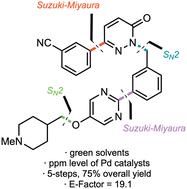抗肿瘤药物替波替尼的快速可持续合成
IF 9.2
1区 化学
Q1 CHEMISTRY, MULTIDISCIPLINARY
引用次数: 0
摘要
抗癌药物替波替尼的合成只需要5个步骤(其中3个步骤是最长的线性序列),总收率为75%。这与默克公司使用的方法相比非常有利,据报道,默克公司的线性序列需要8个步骤来生产这种药物,总产量为27%。此外,需要相对大量的贵金属催化剂(即钯),所有的反应都在有毒溶剂中进行。相比之下,现在有一种新的更环保的方法,不仅效率更高,而且在两个关键的Suzuki-Miyaura接头中使用ppm水平的Pd和水介质。本文章由计算机程序翻译,如有差异,请以英文原文为准。

Short and sustainable synthesis of the anticancer agent tepotinib
Synthesis of the anticancer drug tepotinib was achieved in only 5 steps (3 steps in the longest linear sequence), with an overall yield of 75%. This compares very favorably with that used by Merck, where a linear sequence is reported requiring 8 steps to this drug in 27% overall yield. Moreover, relatively high amounts of precious metal catalyst (i.e., Pd) are needed, all reactions being carried out in toxic solvents. By contrast, a new and greener approach is now available that not only is far more efficient, but also, uses ppm level quantities of Pd and an aqueous medium for the two key Suzuki–Miyaura couplings.
求助全文
通过发布文献求助,成功后即可免费获取论文全文。
去求助
来源期刊

Green Chemistry
化学-化学综合
CiteScore
16.10
自引率
7.10%
发文量
677
审稿时长
1.4 months
期刊介绍:
Green Chemistry is a journal that provides a unique forum for the publication of innovative research on the development of alternative green and sustainable technologies. The scope of Green Chemistry is based on the definition proposed by Anastas and Warner (Green Chemistry: Theory and Practice, P T Anastas and J C Warner, Oxford University Press, Oxford, 1998), which defines green chemistry as the utilisation of a set of principles that reduces or eliminates the use or generation of hazardous substances in the design, manufacture and application of chemical products. Green Chemistry aims to reduce the environmental impact of the chemical enterprise by developing a technology base that is inherently non-toxic to living things and the environment. The journal welcomes submissions on all aspects of research relating to this endeavor and publishes original and significant cutting-edge research that is likely to be of wide general appeal. For a work to be published, it must present a significant advance in green chemistry, including a comparison with existing methods and a demonstration of advantages over those methods.
 求助内容:
求助内容: 应助结果提醒方式:
应助结果提醒方式:


